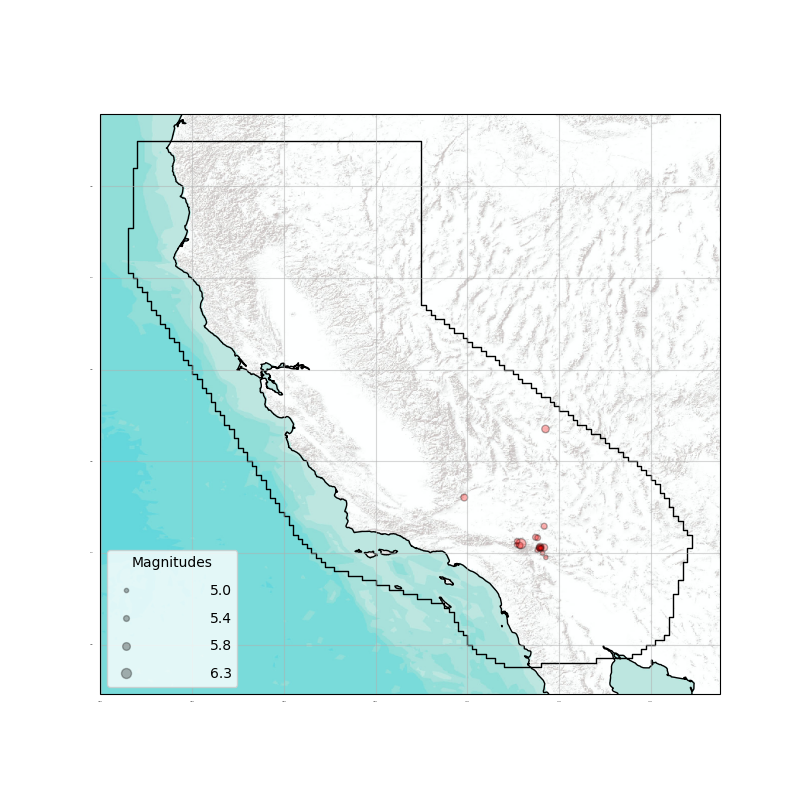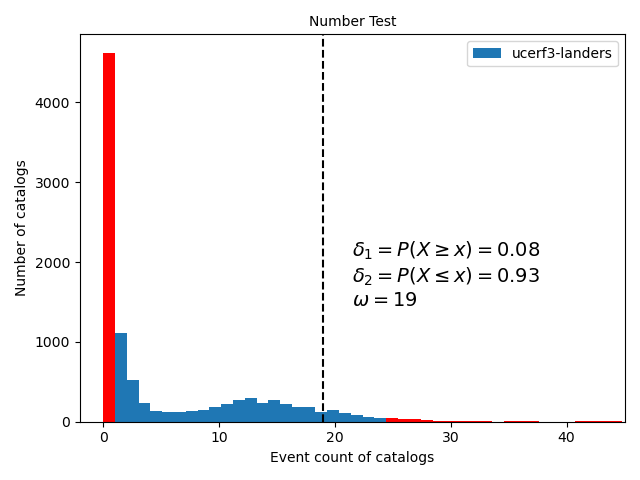Note
Go to the end to download the full example code.
Catalog-based Forecast Evaluation
This example shows how to evaluate a catalog-based forecasting using the Number test. This test is the simplest of the evaluations.
- Overview:
Define forecast properties (time horizon, spatial region, etc).
Access catalog from ComCat
Filter catalog to be consistent with the forecast properties
Apply catalog-based number test to catalog
Visualize results for catalog-based forecast
Load required libraries
Most of the core functionality can be imported from the top-level csep package. Utilities are available from the
csep.utils subpackage.
import csep
from csep.core import regions, catalog_evaluations
from csep.utils import datasets, time_utils
Define start and end times of forecast
Forecasts should define a time horizon in which they are valid. The choice is flexible for catalog-based forecasts, because the catalogs can be filtered to accommodate multiple end-times. Conceptually, these should be separate forecasts.
start_time = time_utils.strptime_to_utc_datetime("1992-06-28 11:57:35.0")
end_time = time_utils.strptime_to_utc_datetime("1992-07-28 11:57:35.0")
Define spatial and magnitude regions
Before we can compute the bin-wise rates we need to define a spatial region and a set of magnitude bin edges. The magnitude
bin edges # are the lower bound (inclusive) except for the last bin, which is treated as extending to infinity. We can
bind these # to the forecast object. This can also be done by passing them as keyword arguments
into csep.load_catalog_forecast().
# Magnitude bins properties
min_mw = 4.95
max_mw = 8.95
dmw = 0.1
# Create space and magnitude regions. The forecast is already filtered in space and magnitude
magnitudes = regions.magnitude_bins(min_mw, max_mw, dmw)
region = regions.california_relm_region()
# Bind region information to the forecast (this will be used for binning of the catalogs)
space_magnitude_region = regions.create_space_magnitude_region(region, magnitudes)
Load catalog forecast
To reduce the file size of this example, we’ve already filtered the catalogs to the appropriate magnitudes and spatial locations. The original forecast was computed for 1 year following the start date, so we still need to filter the catalog in time. We can do this by passing a list of filtering arguments to the forecast or updating the class.
By default, the forecast loads catalogs on-demand, so the filters are applied as the catalog loads. On-demand means that until we loop over the forecast in some capacity, none of the catalogs are actually loaded.
More fine-grain control and optimizations can be achieved by creating a csep.core.forecasts.CatalogForecast directly.
forecast = csep.load_catalog_forecast(datasets.ucerf3_ascii_format_landers_fname,
start_time = start_time, end_time = end_time,
region = space_magnitude_region,
apply_filters = True)
# Assign filters to forecast
forecast.filters = [f'origin_time >= {forecast.start_epoch}', f'origin_time < {forecast.end_epoch}']
Obtain evaluation catalog from ComCat
The csep.core.forecasts.CatalogForecast provides a method to compute the expected number of events in spatial cells. This
requires a region with magnitude information.
We need to filter the ComCat catalog to be consistent with the forecast. This can be done either through the ComCat API or using catalog filtering strings. Here we’ll use the ComCat API to make the data access quicker for this example. We still need to filter the observed catalog in space though.
# Obtain Comcat catalog and filter to region.
comcat_catalog = csep.query_comcat(start_time, end_time, min_magnitude=forecast.min_magnitude)
# Filter observed catalog using the same region as the forecast
comcat_catalog = comcat_catalog.filter_spatial(forecast.region)
print(comcat_catalog)
# Plot the catalog
comcat_catalog.plot()

Fetched ComCat catalog in 0.2949998378753662 seconds.
Downloaded catalog from ComCat with following parameters
Start Date: 1992-06-28 12:00:45+00:00
End Date: 1992-07-24 18:14:36.250000+00:00
Min Latitude: 33.901 and Max Latitude: 36.705
Min Longitude: -118.067 and Max Longitude: -116.285
Min Magnitude: 4.95
Found 19 events in the ComCat catalog.
Name: None
Start Date: 1992-06-28 12:00:45+00:00
End Date: 1992-07-24 18:14:36.250000+00:00
Latitude: (33.901, 36.705)
Longitude: (-118.067, -116.285)
Min Mw: 4.95
Max Mw: 6.3
Event Count: 19
<GeoAxes: >
Perform number test
We can perform the Number test on the catalog based forecast using the observed catalog we obtained from Comcat.
number_test_result = catalog_evaluations.number_test(forecast, comcat_catalog)
Processed 1 catalogs in 0.0012803077697753906 seconds
Processed 2 catalogs in 0.0017325878143310547 seconds
Processed 3 catalogs in 0.002131938934326172 seconds
Processed 4 catalogs in 0.002412080764770508 seconds
Processed 5 catalogs in 0.0026826858520507812 seconds
Processed 6 catalogs in 0.003053426742553711 seconds
Processed 7 catalogs in 0.003324747085571289 seconds
Processed 8 catalogs in 0.003731966018676758 seconds
Processed 9 catalogs in 0.00468134880065918 seconds
Processed 10 catalogs in 0.0050411224365234375 seconds
Processed 20 catalogs in 0.008867502212524414 seconds
Processed 30 catalogs in 0.01295614242553711 seconds
Processed 40 catalogs in 0.016607999801635742 seconds
Processed 50 catalogs in 0.02075505256652832 seconds
Processed 60 catalogs in 0.02426934242248535 seconds
Processed 70 catalogs in 0.02760791778564453 seconds
Processed 80 catalogs in 0.03125190734863281 seconds
Processed 90 catalogs in 0.03504371643066406 seconds
Processed 100 catalogs in 0.03836703300476074 seconds
Processed 200 catalogs in 0.07099199295043945 seconds
Processed 300 catalogs in 0.10698151588439941 seconds
Processed 400 catalogs in 0.14195680618286133 seconds
Processed 500 catalogs in 0.2055041790008545 seconds
Processed 600 catalogs in 0.24000763893127441 seconds
Processed 700 catalogs in 0.2749521732330322 seconds
Processed 800 catalogs in 0.34209680557250977 seconds
Processed 900 catalogs in 0.37566685676574707 seconds
Processed 1000 catalogs in 0.41100311279296875 seconds
Processed 2000 catalogs in 0.9079108238220215 seconds
Processed 3000 catalogs in 1.3686177730560303 seconds
Processed 4000 catalogs in 1.8394980430603027 seconds
Processed 5000 catalogs in 2.302907705307007 seconds
Processed 6000 catalogs in 2.765509843826294 seconds
Processed 7000 catalogs in 3.249851703643799 seconds
Processed 8000 catalogs in 3.678293466567993 seconds
Processed 9000 catalogs in 4.190564870834351 seconds
Processed 10000 catalogs in 4.6541008949279785 seconds
Plot number test result
We can create a simple visualization of the number test from the evaluation result class.
ax = number_test_result.plot(show=True)

Total running time of the script: (0 minutes 9.381 seconds)